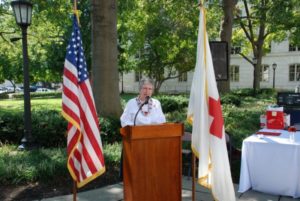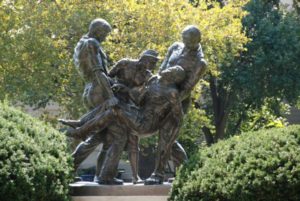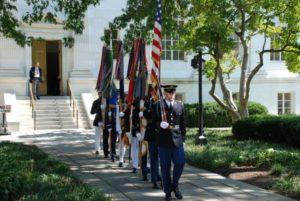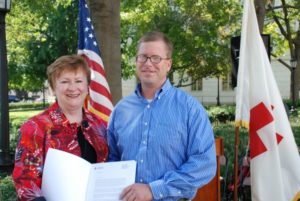Chris Walters is a freelance writer/editor. He lives in Arlington, Virginia with his wife and their cat.
 I can truly say that the Red Cross is in my blood. As World War II raged, a young Red Cross volunteer named Adele Werthessen met an Army sergeant named James Murton on the docks of New York. They didn’t exactly hit it off, but between New York, England, and France, a lasting connection was made. After the war, my grandmother spent much of her life with the Red Cross. Their daughter, my mother, also married a military man and has similarly spent much of her life as a Red Cross volunteer or employee.
I can truly say that the Red Cross is in my blood. As World War II raged, a young Red Cross volunteer named Adele Werthessen met an Army sergeant named James Murton on the docks of New York. They didn’t exactly hit it off, but between New York, England, and France, a lasting connection was made. After the war, my grandmother spent much of her life with the Red Cross. Their daughter, my mother, also married a military man and has similarly spent much of her life as a Red Cross volunteer or employee.
On Friday, the American Red Cross Overseas Association (ARCOA) honored those who served and have served overseas in a ceremony in the Memorial Garden at National Headquarters. Washington DC is rarely graced by weather that anyone would call perfect, but Friday, in a warm sunlit garden, with leaves still green on the trees, came as close as we’re likely to get. With the blessing of nature, and in front of a statue that honors the 78 members of the Red Cross who died in WWII, the speakers reached back 150 years, to 1862 and the battle of Antietam, where Clara Barton earned her nickname, the Angel of the Battlefield. There is a red line reaching back in time, from Clara Barton using corn husks to bind wounds when bandages ran out, through the medical volunteers and Donut Dollies of the world wars, to the Red Cross staff and volunteers who are still serving the armed forces today in places like Afghanistan. This annual ceremony is a way to make that red line more visible and strengthen it through the legacy, the stories of those involved. It is also a way to honor those that have passed away, more than two dozen names were read by my mother in this year’s roll call of those who have died.
When I was younger, I didn’t think to ask my grandmother about her time in Europe during the war. I know some of the stories, but not as much as I realize that I should. Now, I can’t ask her. On Friday, I got to connect with my grandmother through other people’s stories. I spoke with Mary O’Driscoll, who in 1944 put five options in a hat and picked one as her way to serve, it was being a censor for mail from the front. On her way to apply to be a censor, she saw a friend coming out of the local Red Cross office, she got off the tram, walked in, and volunteered. Mary thought that she would be a secretary; instead, she was told to pack a bag, including a dress for dancing, and prepare to travel. Most of the Ohio boys from her area were going to the Pacific and Mary thought that she would be going there. Mary ended up in arriving in frigid Glasgow, Scotland on the Aquitania. Along with her friend, she volunteered to be a club girl, providing doughnuts and cheer to the soldiers. Mary’s first assignment was to provide food and cheer for wounded soldiers being loaded onto the Queen Mary for the voyage home. On her first day, Mary was told to be happy for those soldiers, because they were going home. The man who told her that was a wounded soldier himself, in her words, “he didn’t have a face, it was gone, but he said that there were surgeons back home, and that they could help him and make him a face that was acceptable.” She didn’t cry after that day. Mary went on to the 8th Air Force and then the “cigarette camps,” the massive debarkation camps for soldiers returning home after Germany was defeated. At one of those camps, she provided milkshakes for emaciated former POWs, to help them put on some weight. Mary did get to use that dress once, in a freezing wedding ceremony in Scotland, holding a bunch of tulips, the only flowers that she could find.
Sue Richter was a teacher during Vietnam, and she wanted to serve as well. After seeing an article about the Donut Dollies, she went to the Red Cross and volunteered to do that; however, at twenty three or maybe twenty four, Sue was “too old” for that, but mature enough to serve in a hospital. At the time, Sue didn’t want to be a Red Cross “lifer,” but 43 years later, she’s still with the Red Cross.
The stories that I heard from Mary, Sue, and other women that I talked with aren’t my grandmother’s story, but in so many ways, they are her story, and I feel closer to her now.



